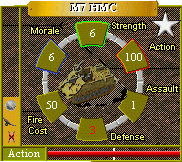
Game Statistics

|
| Victory Points |
Armour | Start | Start | End | End | ||
| Front | Side | Rear | Month | Year | Month | Year | |
| 6 | 3 | 1 | 1 | 11 | 42 | 5 | 45 |
| M7 105mm SP Howitzers | |||||||||||||||||||||||||||
| RANGE | 1 | 2 | 3 | 4 | 5 | 6 | 7 | 8 | 9 | 10 | 11 | 12 | 13 | 14 | 15 | 16 | 17 | 18 | 19 | 20 | 30 | 40 | 50 | 60 | 70 | 80 | |
| HARD | 10 | 8 | 6 | 3 | 1 | 1 | 1 | 1 | 1 | 1 | 1 | 1 | 1 | 1 | 1 | 1 | 1 | 1 | 1 | 1 | 1 | 1 | . | . | . | . | |
| SOFT | 18 | 18 | 18 | 17 | 17 | 17 | 16 | 16 | 16 | 15 | 15 | 15 | 15 | 14 | 14 | 14 | 14 | 13 | 13 | 13 | 10 | 8 | . | . | . | . | |
History
|
|
|
Specification |
|
Almost as soon as the Medium Tank M3 was off the drawing board plans were being made to convert its chassis to accommodate a 105 mm(4.14 in)howitzer for issue to armored artillery units supporting tank operations.The upper hull was drastically modified to mount the 105 mm howitzer in an off-center position.A large drum-like cupola was added to the right-hand superstructure to allow a 0.50 in(12.7 mm)machine gun to be placed on a ring mounting for air and local defence.Trails vehicles were known as the T32 and by February 1942 it was standardized as the Howitzer Motor Gun Carriage M7. |